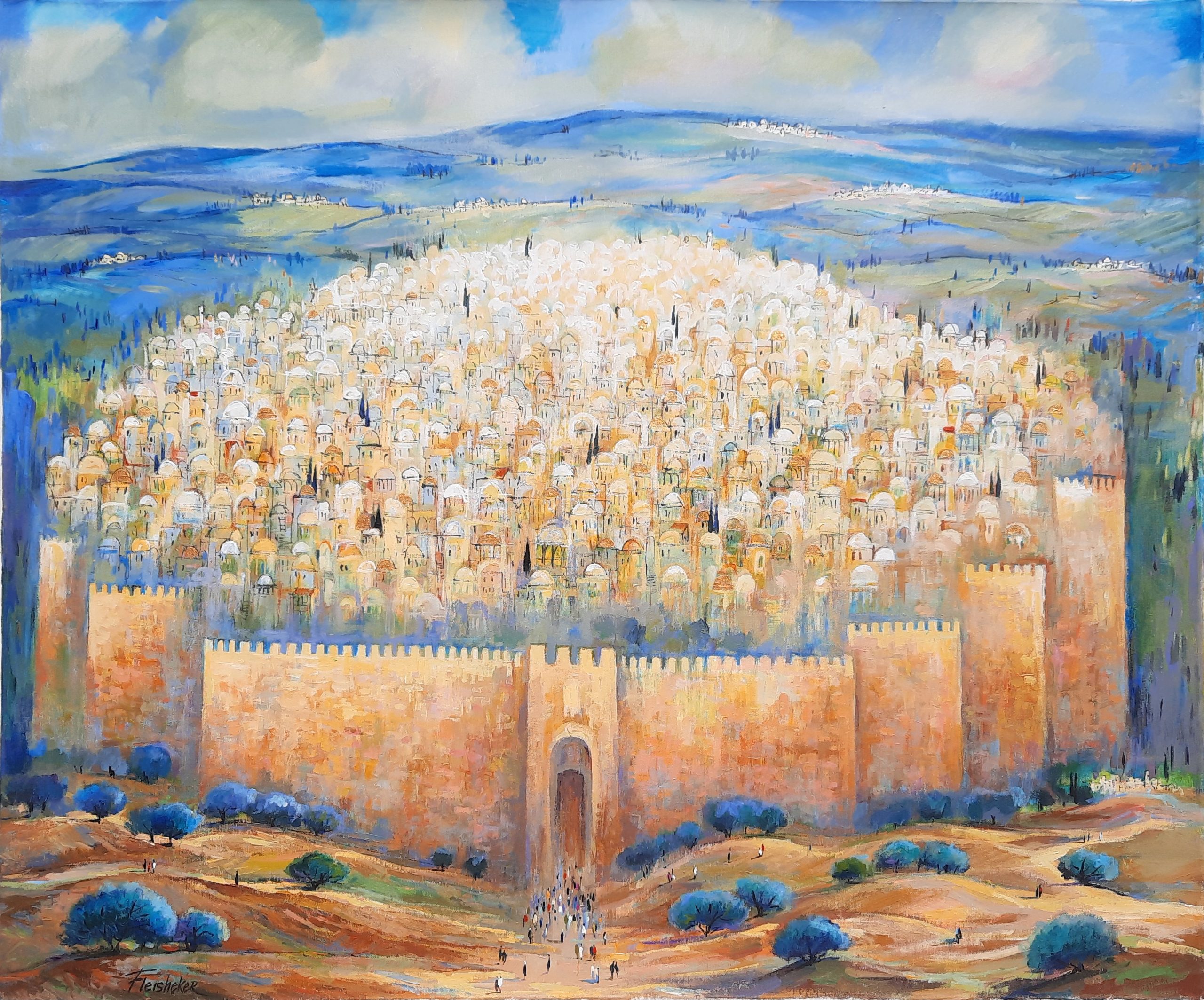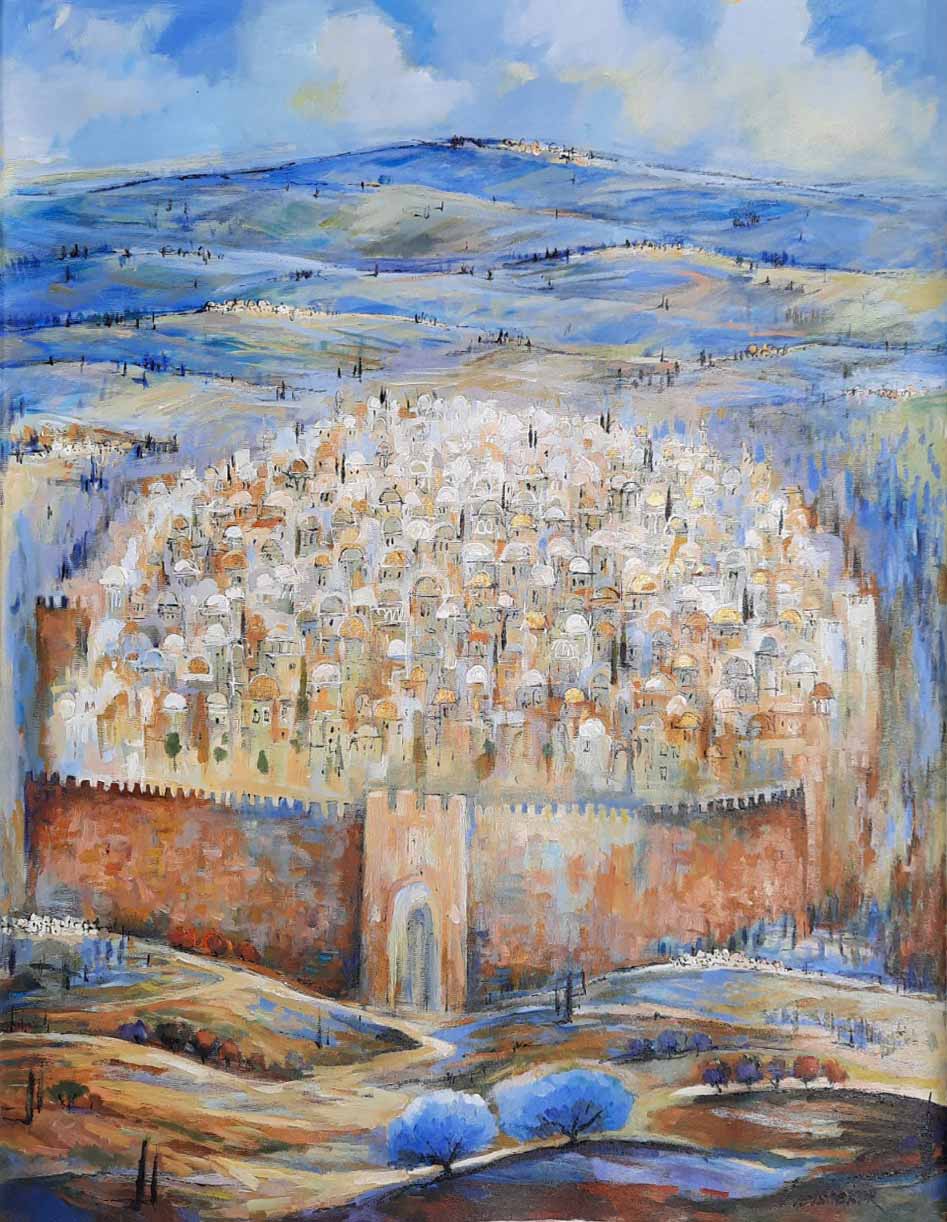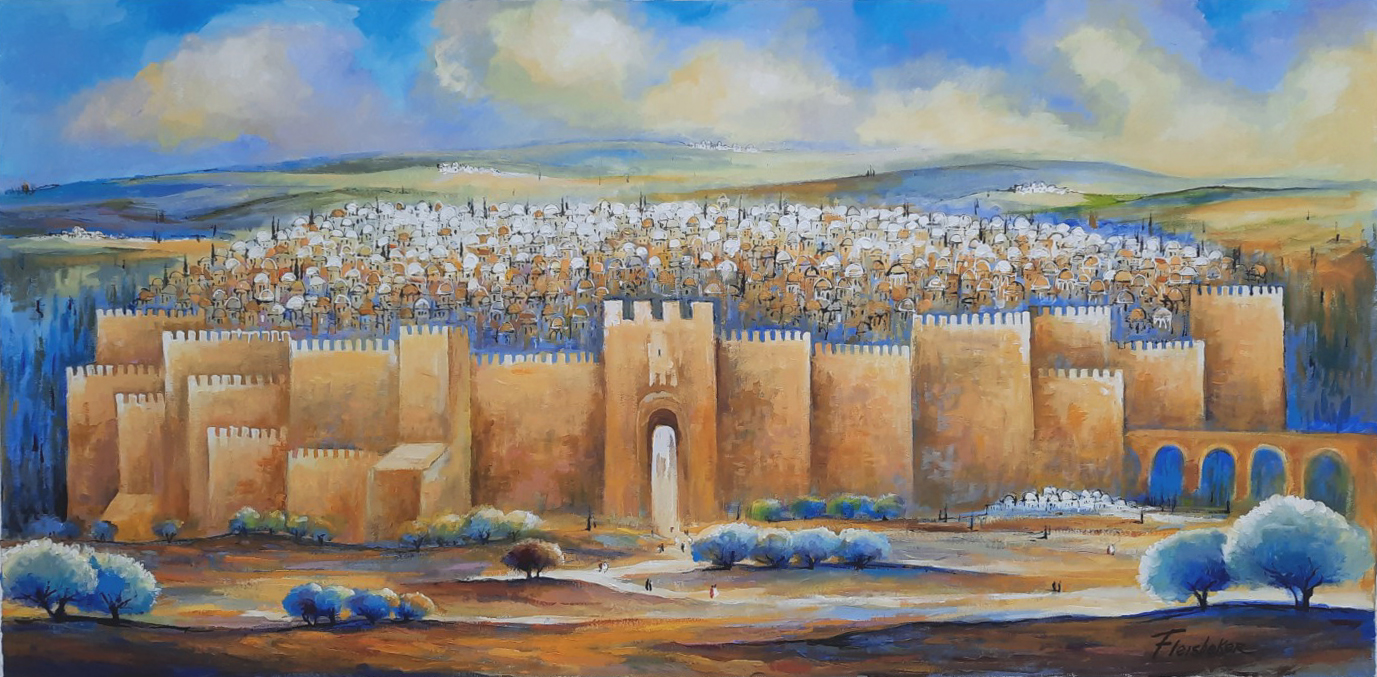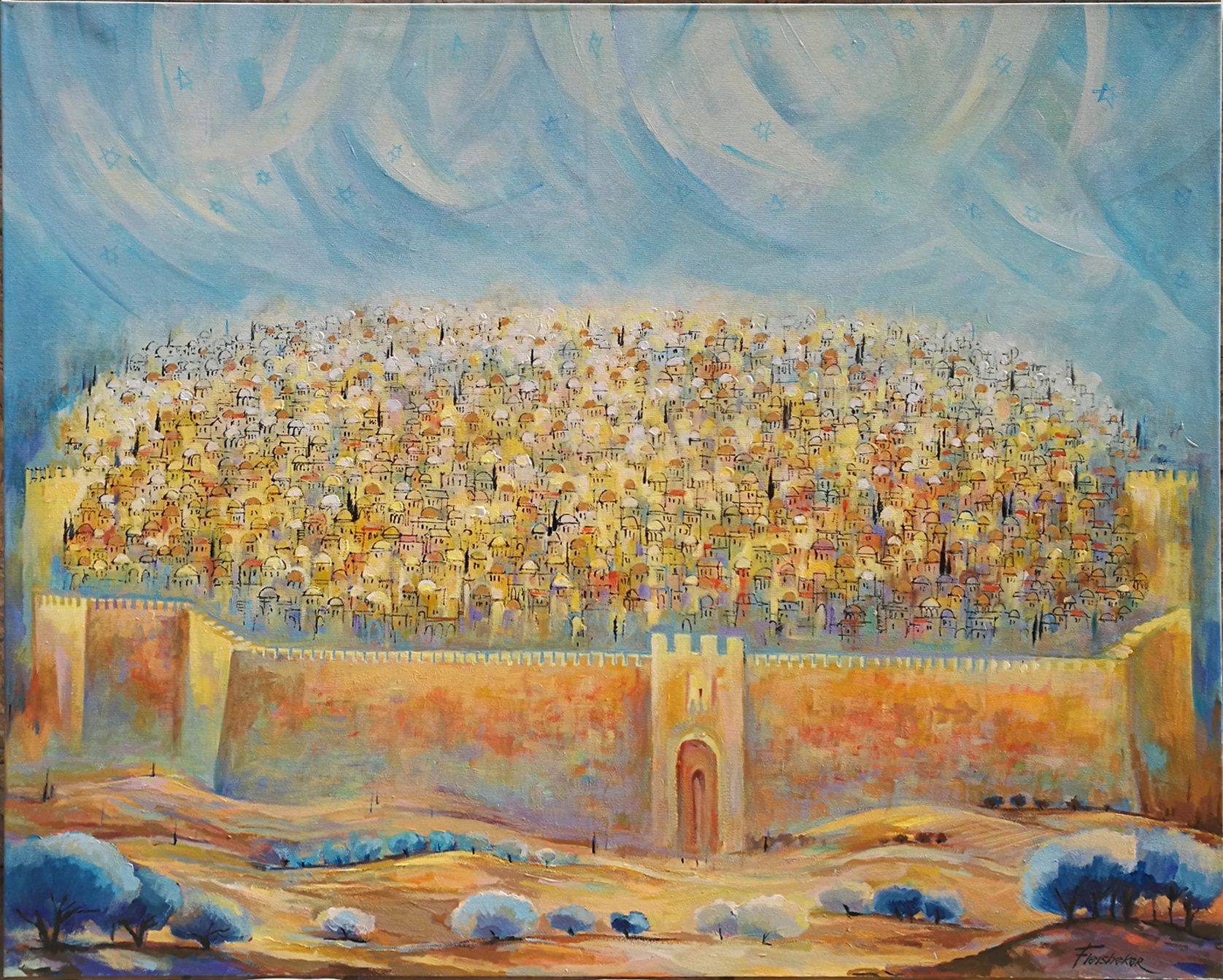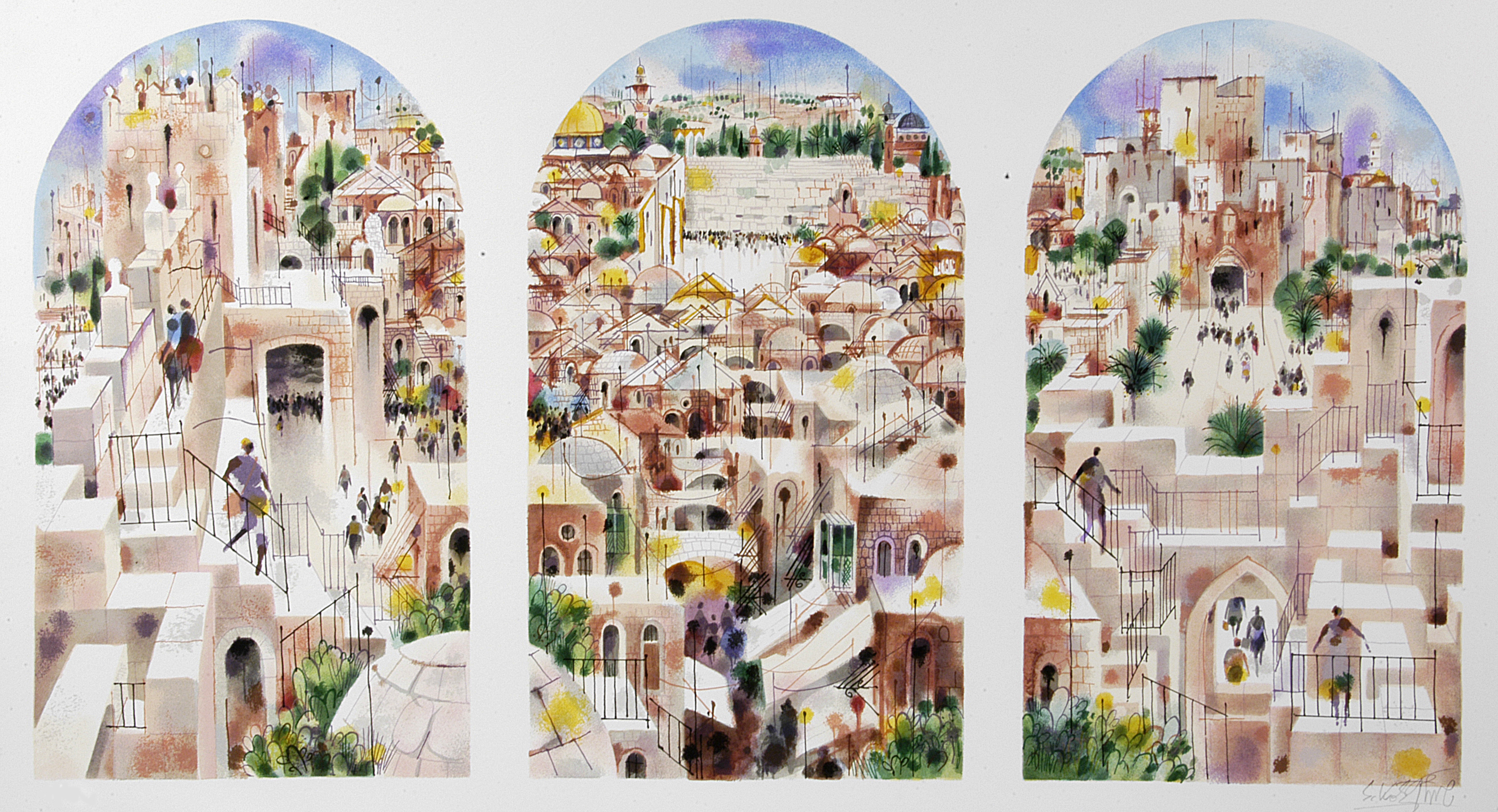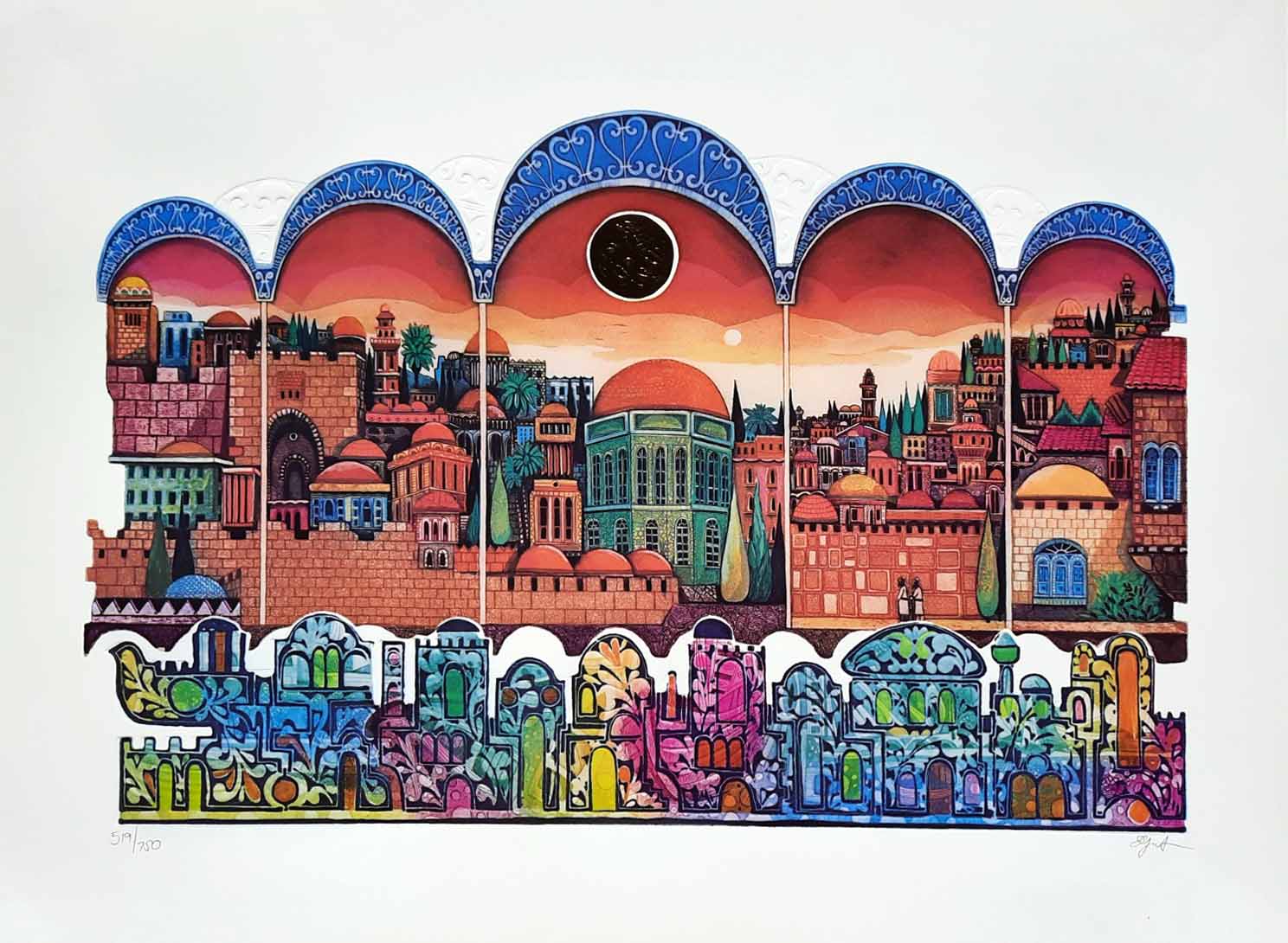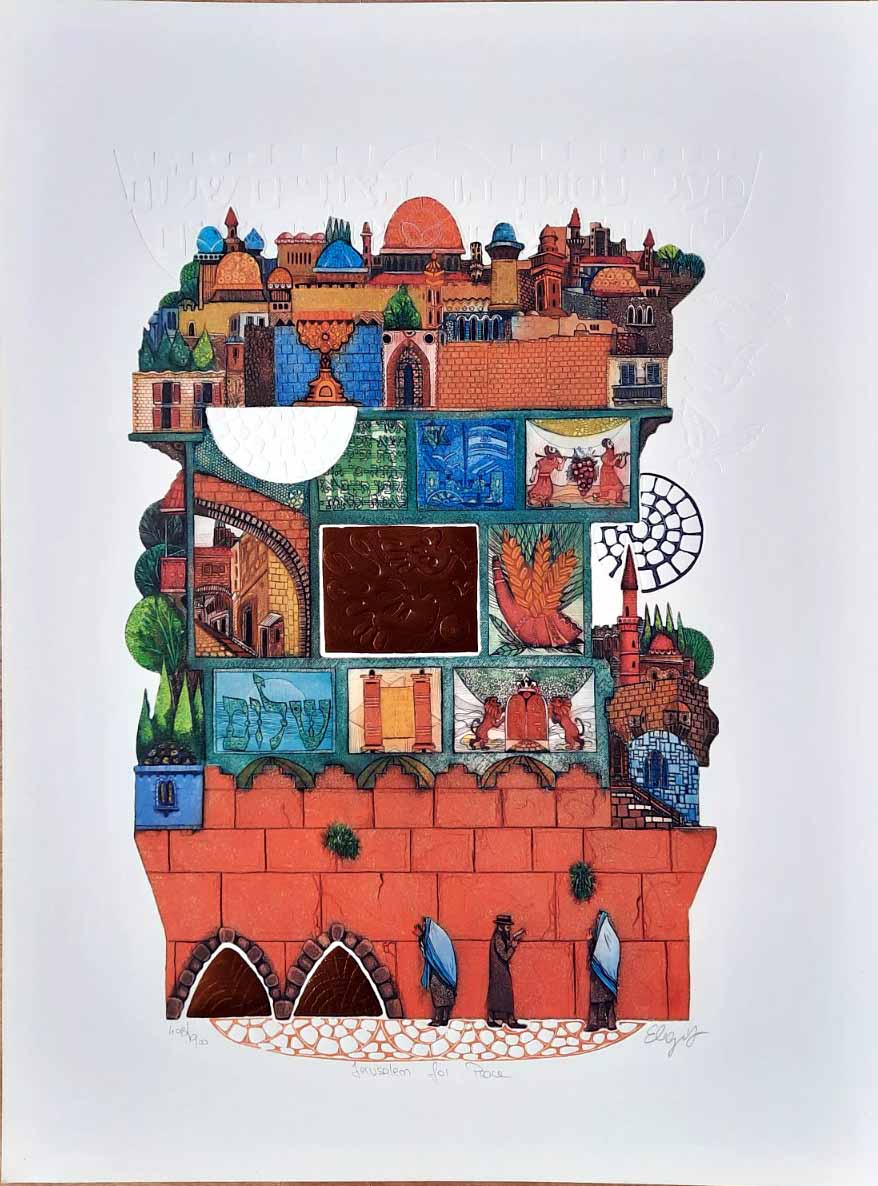Search Results for: Jerusalem
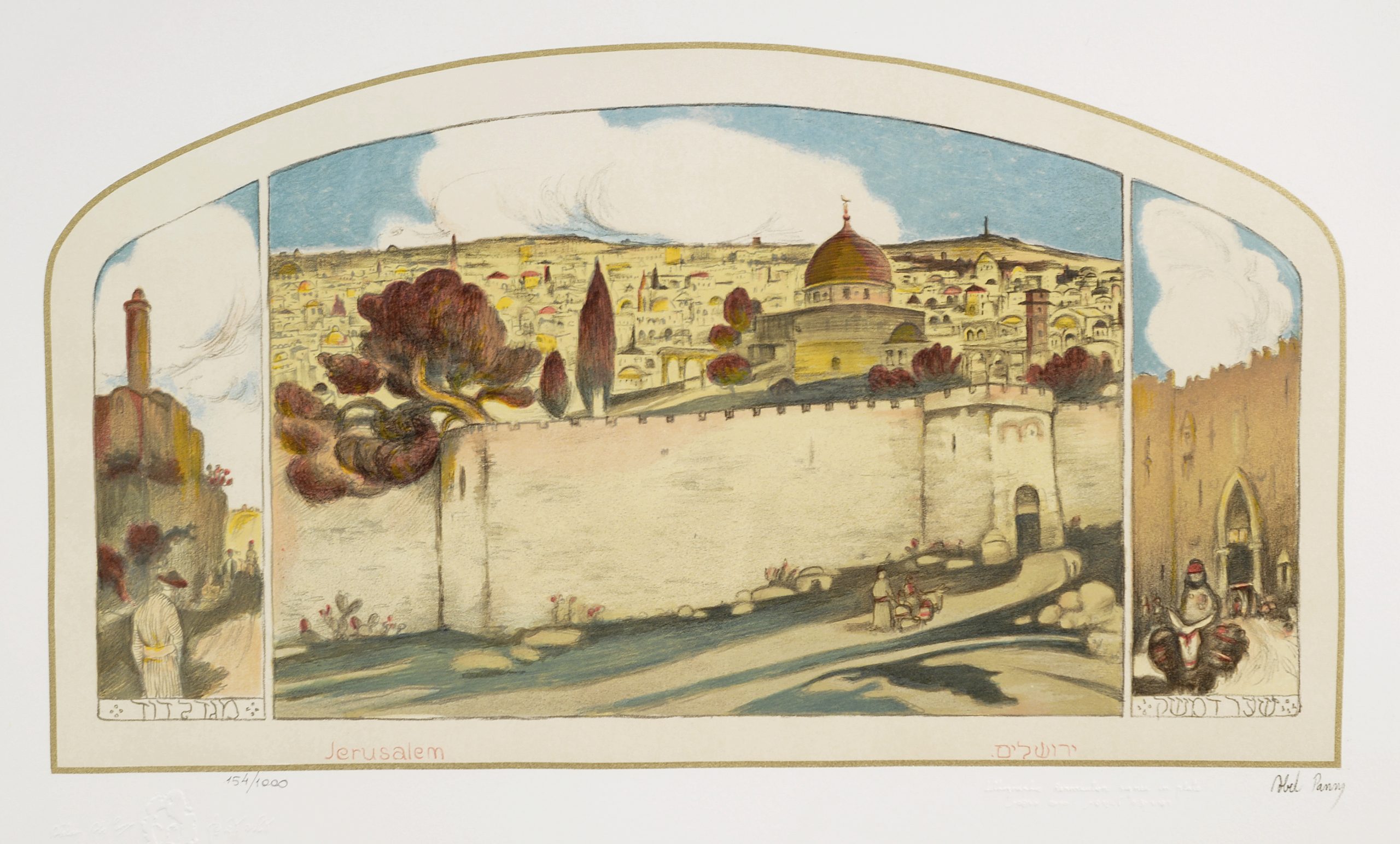
Pann Abel
Jerusalem
$200
Shipping & Handling: $30
Abel Pann was born in Lithouania.
He began his artistic studies in Odessa and continued them in Paris. A number of his pictures have been acquired by the French Government, by the Municipality of Paris, by the Museum of Luzembourg and by the Art Institute of Chicago and a series of 45 pictures has been purchased in America for the National Museum of Jerusalem.
The Palestine Art Publishing Co. Ltd Jerusalem
Abel Pann wrote:
The task I have set myself involves a serious responsibility. The enthusiasm which my work arouses in me is often clouded by painful doubts and questionings. For that same Book which has inspired many a genius to produce his masterpiece has proved to be beyond the reach of a far greater number of artists.
A son of the race which produced this marvelous Book. I feel that I, better than some others, may be able to seize its true spirit, and to communicate it to my fellow-men.
But the absolute truth is with G-d alone. Mankind is ever the subject to error. And so I entreat the indulgence of my judges.
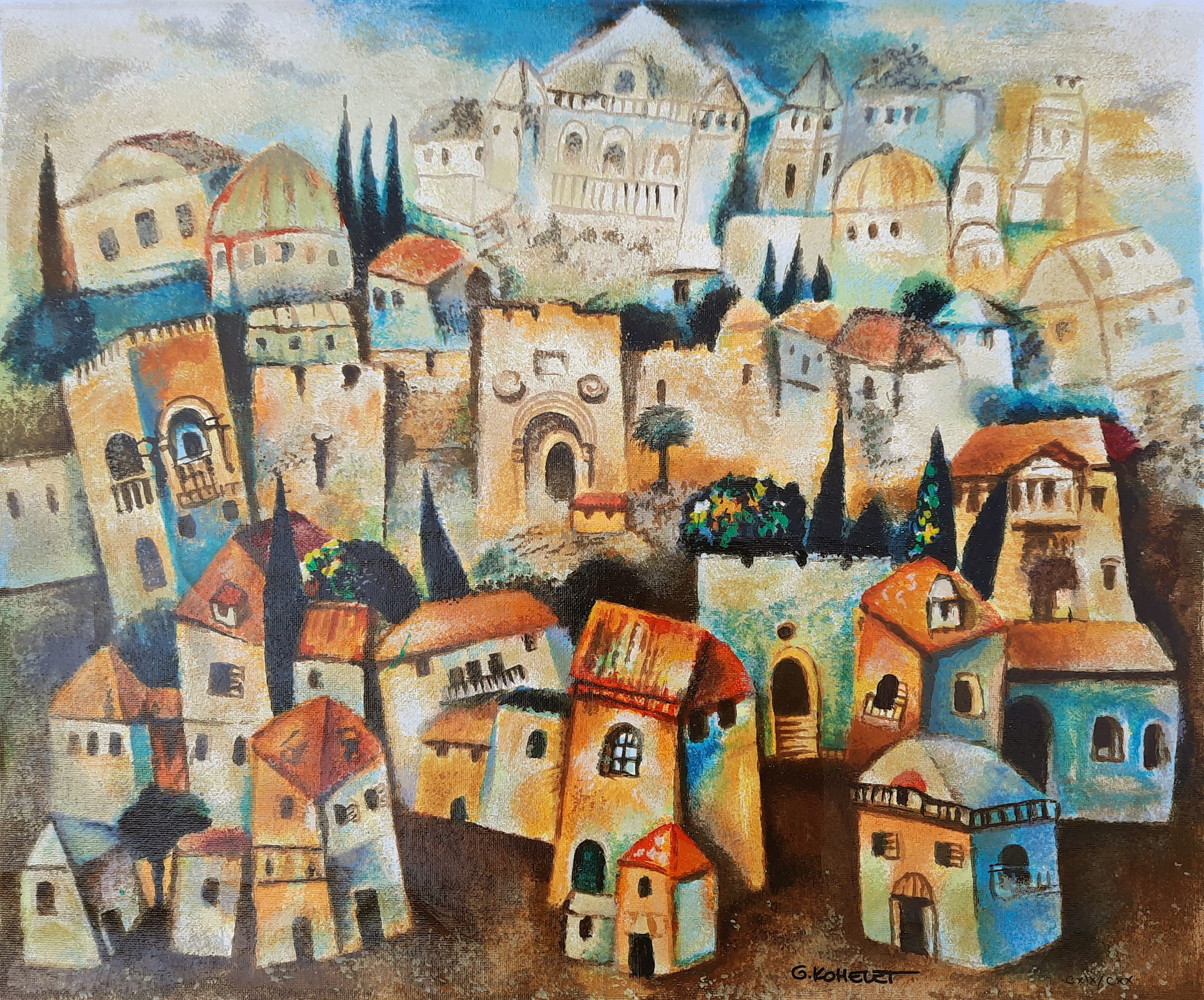
Gregory Kohelet
Jerusalem IV
$200
Edition 120
Shipping & Handling: $30
Gregory Kohelet was born in 1954 in Fergana.
The son of a sculptor, Gregory was initiated into art by his father. He wasn’t pressured to learn “the classical laws of Art” but only to love and respect nature – the master teacher.
As a young boy, Gregory traveled with his father to wild landscapes with the intention of learning to understand the meaning of composition, color, and expression as they exist in Nature.
There, he listened to the music, understood the wisdom of the stones. Nature taught him to listen to silence. He thought that if he were to stay there he would become a Buddhist. But his was a different destiny.
He left his parents and his town Fergana at the age of 14 and went to study art in Tashkent.
He studied painting for 4 years at the Art College, and then for five more years at the Academy of Art.
He had excellent teachers, many from Moscow and St. Petersburg.
At College he was particularly influenced by Eastern art: Japanese, Chinese, Indian, while at the Academy he studied European Art: Giotto, Bruegel, Modigliani, More, Brancusi and Russian icons.
Yet he felt that his life’s course must pass through Jerusalem. In 1990 he immigrated with his family to Israel and settled in Jerusalem. In the holy city he absorbed much light and divine inspiration. He believes in G-d, but only in Jerusalem did he really “meet” him.
His influences from literature: The Bible essentially, Rilke, Matzu-Batzu (China), Lorca (Spain), Eluard (France)…
His influences from the world of music: Mozart, Bach, organ and liturgical (Armenian, Catholic, Jewish…)
His family is also a source of inspiration. His son Daniel – born in Jerusalem, his first son – born in Tashkent, and his wife, who dominates the female figure in his work.
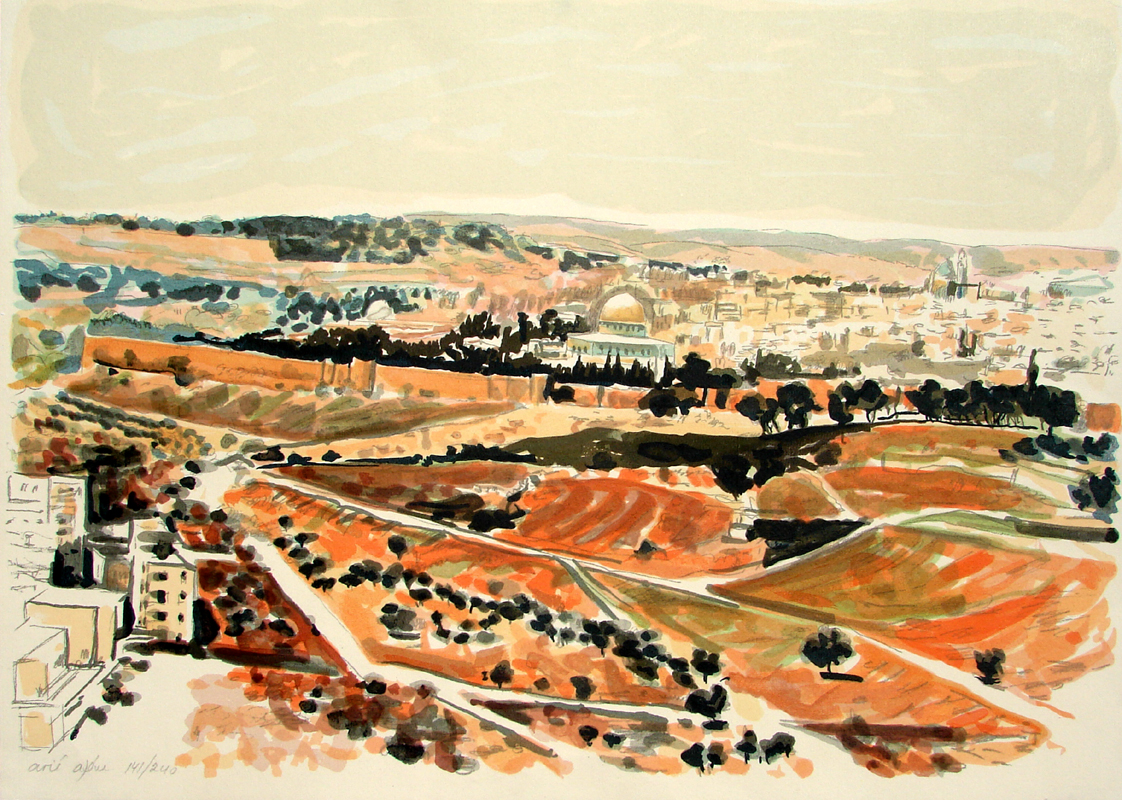
Azen
Jerusalem
$200
Shipping & Handling: $30
ARIE AZENE
Arie Azene was born in Germany in 1934. He moved to Israel at a young age and grew up in Tel Aviv. During his career as a Master artist he has exhibited in international shows, Museums and Galleries in Israel, Europe and the USA. Many of Azene’s artworks can be found in important private collections.
The original paintings that inspired Azene’s 3D mixed media series were painted in watercolours throughout the 80’s. Inspired by these pictures a new series of oil paintings and 3D mixed media artworks were created by Azene in the last few years
1956 Tel Aviv Museum: Israeli artist
1959 Tel Aviv Museum: new horizons
1963 Ein Harod Museum: new horizons
1963 Biennale – Paris
1965 Tel Aviv Museum: young Artists
1966 Gordon Gallery T.A.
1967 Katz Gallery T.A.
1968 Tel Aviv Museum: Autumn Show
1971 Modern art Museum Haifa: Multism
1971 Tel Aviv artist’s House: Abrstractions
1973 Jerusalem artist’s house
1973 Sara Gilat gallery, Jerusalem
1974 Yodfat Gallery T.A.
1975 Yodfat Gallery T.A.
1979 Israel Museum, Jerusalem: Kadishman connection
1981 Tel Aviv Museum: new works
1985 Art – Expo N.Y.
1985 Art – Expo L.A.
1986 Art – Expo N.Y.
1986 Art – Expo L.A.
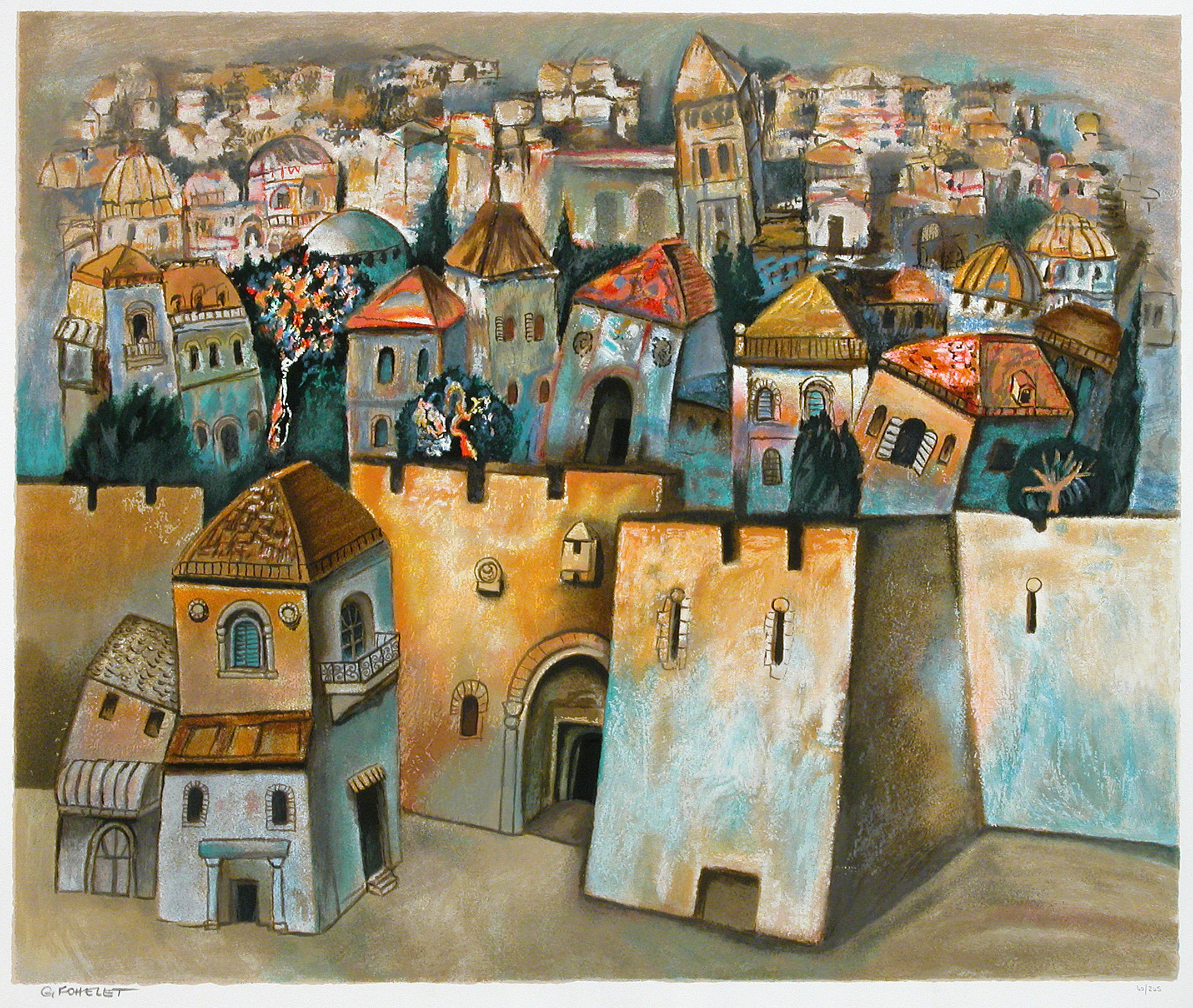
Gregory Kohelet
Jerusalem
$300
Serigraph on Paper2000 Edition 245
Shipping & Handling: $30
Gregory Kohelet was born in 1954 in Fergana.
The son of a sculptor, Gregory was initiated into art by his father. He wasn’t pressured to learn “the classical laws of Art” but only to love and respect nature – the master teacher.
As a young boy, Gregory traveled with his father to wild landscapes with the intention of learning to understand the meaning of composition, color, and expression as they exist in Nature.
There, he listened to the music, understood the wisdom of the stones. Nature taught him to listen to silence. He thought that if he were to stay there he would become a Buddhist. But his was a different destiny.
He left his parents and his town Fergana at the age of 14 and went to study art in Tashkent.
He studied painting for 4 years at the Art College, and then for five more years at the Academy of Art.
He had excellent teachers, many from Moscow and St. Petersburg.
At College he was particularly influenced by Eastern art: Japanese, Chinese, Indian, while at the Academy he studied European Art: Giotto, Bruegel, Modigliani, More, Brancusi and Russian icons.
Yet he felt that his life’s course must pass through Jerusalem. In 1990 he immigrated with his family to Israel and settled in Jerusalem. In the holy city he absorbed much light and divine inspiration. He believes in G-d, but only in Jerusalem did he really “meet” him.
His influences from literature: The Bible essentially, Rilke, Matzu-Batzu (China), Lorca (Spain), Eluard (France)…
His influences from the world of music: Mozart, Bach, organ and liturgical (Armenian, Catholic, Jewish…)
His family is also a source of inspiration. His son Daniel – born in Jerusalem, his first son – born in Tashkent, and his wife, who dominates the female figure in his work.
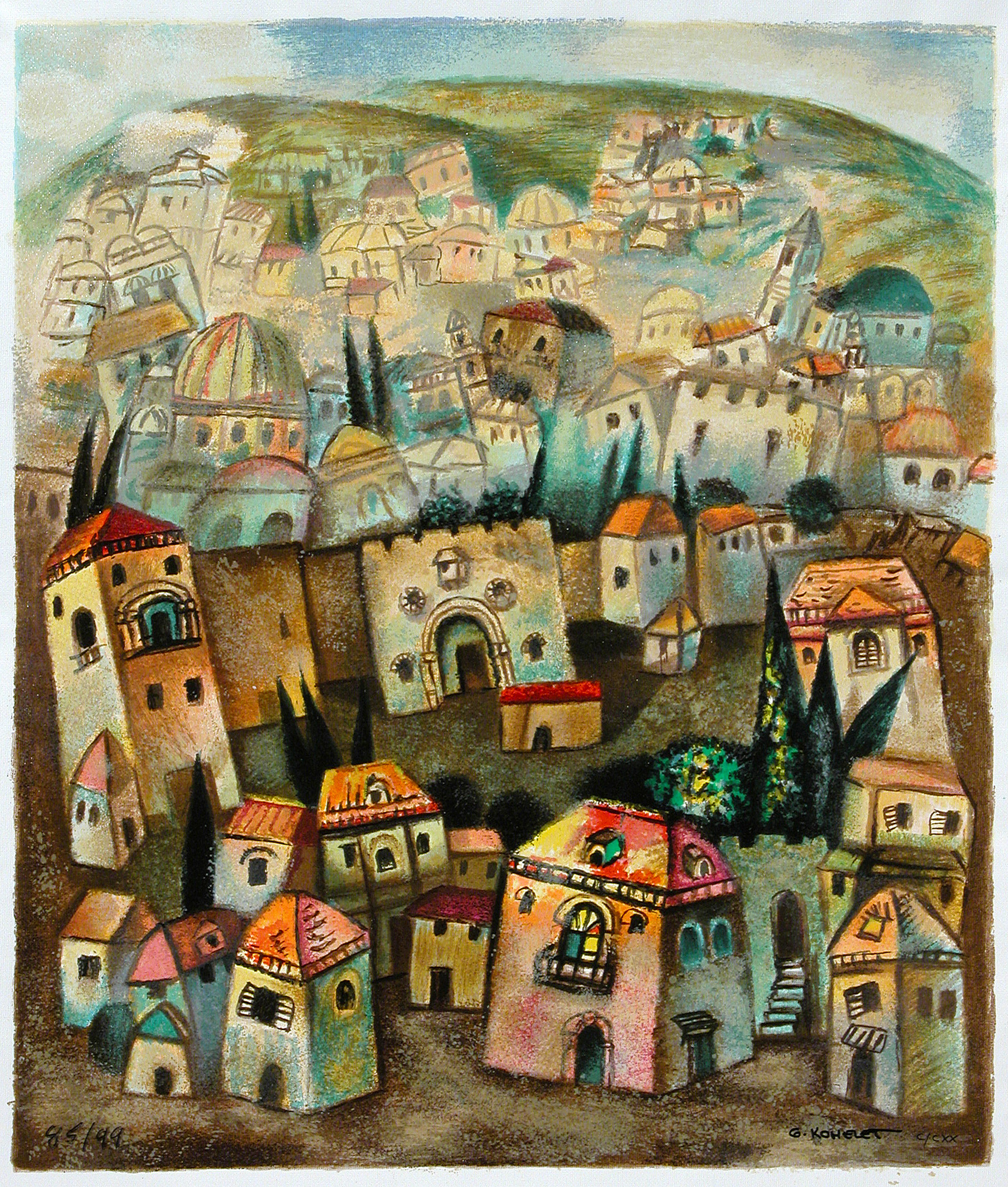
Gregory Kohelet
Jerusalem III
$200
Edition 120
Shipping & Handling: $30
Gregory Kohelet was born in 1954 in Fergana.
The son of a sculptor, Gregory was initiated into art by his father. He wasn’t pressured to learn “the classical laws of Art” but only to love and respect nature – the master teacher.
As a young boy, Gregory traveled with his father to wild landscapes with the intention of learning to understand the meaning of composition, color, and expression as they exist in Nature.
There, he listened to the music, understood the wisdom of the stones. Nature taught him to listen to silence. He thought that if he were to stay there he would become a Buddhist. But his was a different destiny.
He left his parents and his town Fergana at the age of 14 and went to study art in Tashkent.
He studied painting for 4 years at the Art College, and then for five more years at the Academy of Art.
He had excellent teachers, many from Moscow and St. Petersburg.
At College he was particularly influenced by Eastern art: Japanese, Chinese, Indian, while at the Academy he studied European Art: Giotto, Bruegel, Modigliani, More, Brancusi and Russian icons.
Yet he felt that his life’s course must pass through Jerusalem. In 1990 he immigrated with his family to Israel and settled in Jerusalem. In the holy city he absorbed much light and divine inspiration. He believes in G-d, but only in Jerusalem did he really “meet” him.
His influences from literature: The Bible essentially, Rilke, Matzu-Batzu (China), Lorca (Spain), Eluard (France)…
His influences from the world of music: Mozart, Bach, organ and liturgical (Armenian, Catholic, Jewish…)
His family is also a source of inspiration. His son Daniel – born in Jerusalem, his first son – born in Tashkent, and his wife, who dominates the female figure in his work.
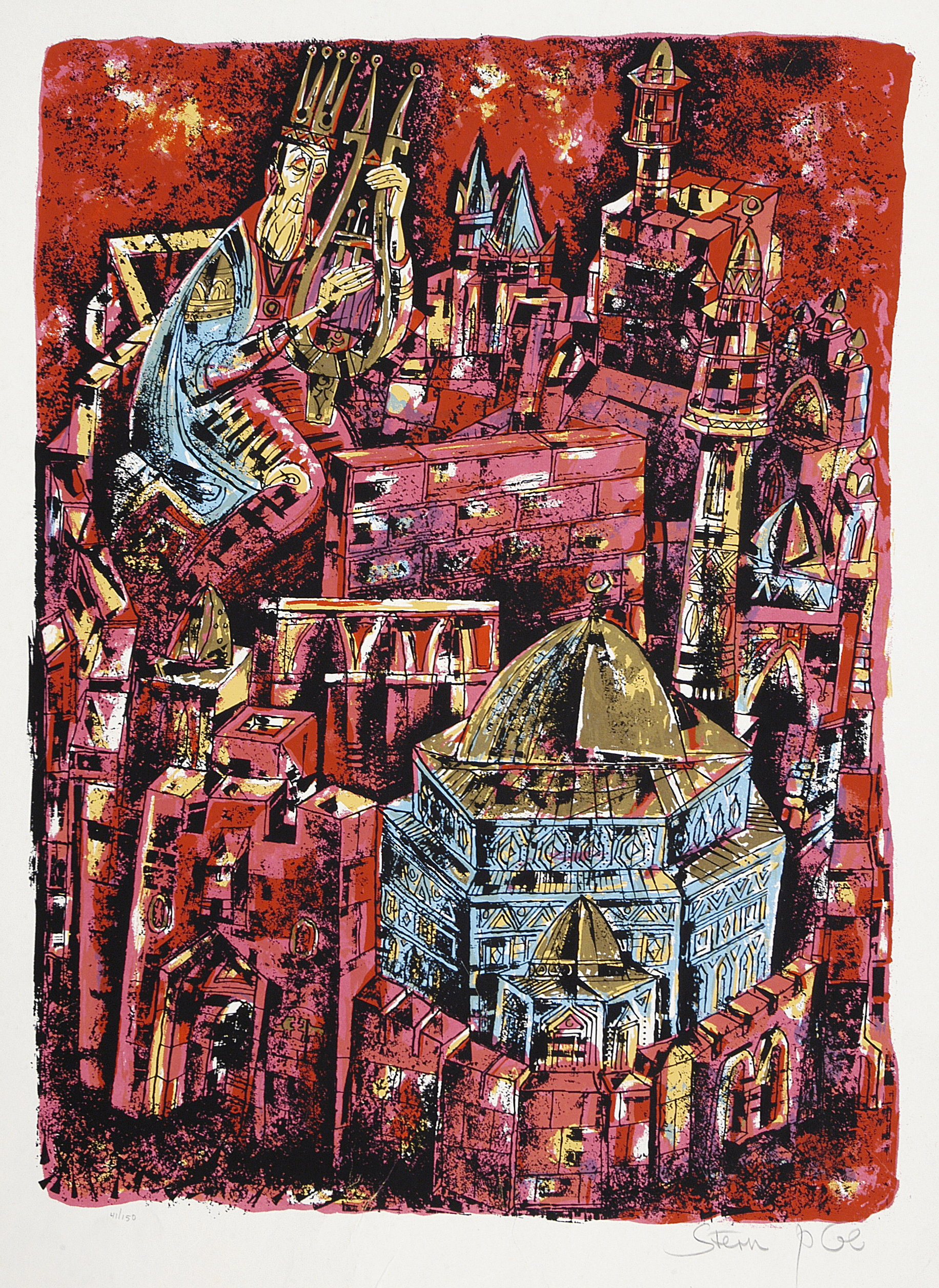
Jossi Stern
S- 57a David over Jerusalem
$200$100
Lithograph1967
Shipping & Handling: $30
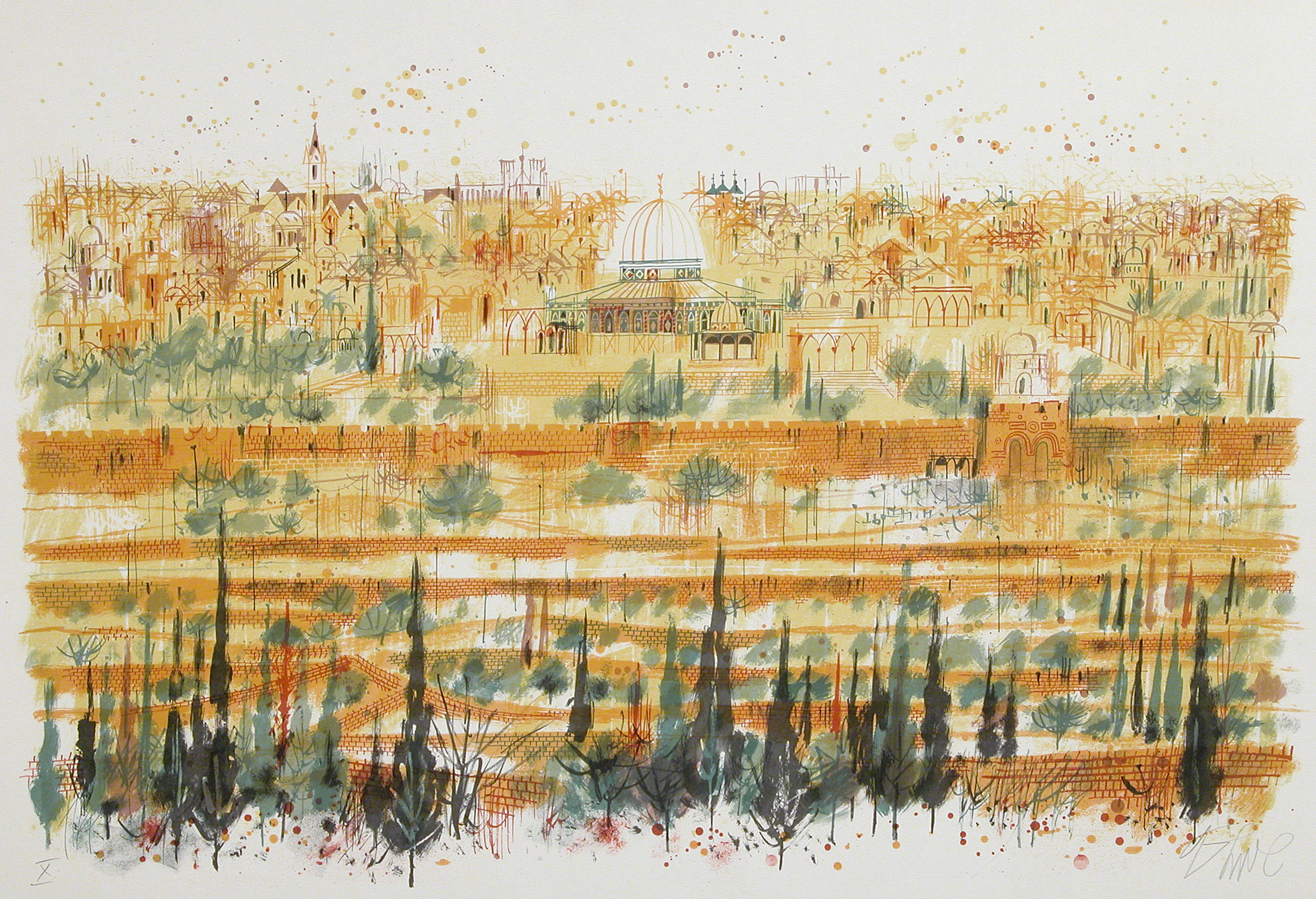
Shemuel Katz
Jerusalem of Gold
$200$100
Serigraph1968 Edition 100
Shipping & Handling: $30
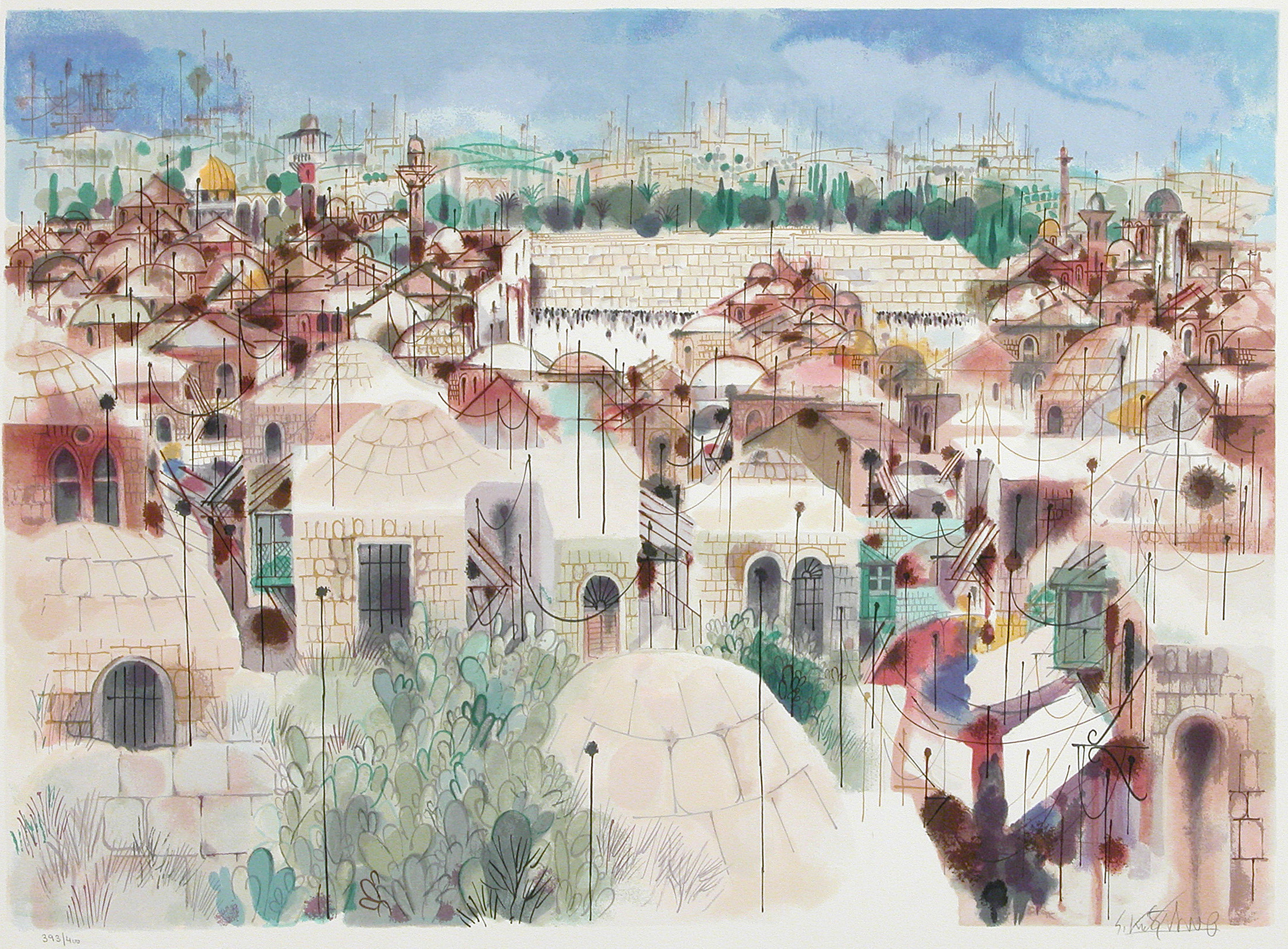
Shemuel Katz
S-253 Jerusalem-The Wall
$300$150
Serigraph1991 Edition 400
Shipping & Handling: $30
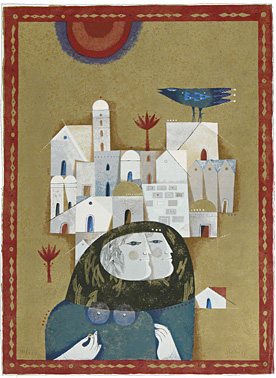
Sami Briss
Couple in Jerusalem
$95
Serigraph1979 Edition 200
Shipping & Handling: $30
SAMI BRISS
Sami Briss was born in Jassy, Rumania, in 1930, and the influence of his youthful surroundings pervades his artwork even to this day. The artist was strongly impressed by the peaceful, rolling beauty of the landscape and the stately architecture of his home city. The churches of his motherland touched his artist’s soul as well, as did their outer frescos of vivid color. Briss inherited a love for design from his mother, a dressmaker. Continually evincing an interest in the rich embroidery of the cloth, Briss early surprised his delighted mother with his own drawings. She encouraged his interest in the arts, and applauded his entering the Beaux-Arts of Bucharest.
At the beginning of his career, Briss painted beautiful still-lifes, which showed his undeniable concern for construction. He experimented successfully with lithography and wood cutting, but in the early sixties devoted his time to painting. The artist works in both oils and water colors. He was taught the art of iconography, another asset stemming from his Rumanian heritage, and made the art his own by the practice of the ancient technique which he has completely transformed by adapting it to the marvelous images he renews in each of his works.
Briss’ paintings, in which the blues, pinks, deep greens, off-whites and blacks predominate, as well as gold leaf, are pieces full of both mystery and certainty. He often calls upon the world of the Bible and the Rumanian folklore of his youth, incorporating both Saints and peasants. But Briss has broken with the past, and created a world quite his own by screening his memories and feelings through his subconsciousness, renewing them continually in his own way. In his art, which is connected to no precise code of contemporary art, he calls upon varied legends to create his own vocabulary of symbols.
The fish appears in his works as the symbol of abundance, hands evoke strength and happiness, and birds in flight emphasize a hope of detachment. Based in his two kingdoms of Paris and Tel Aviv, the land of Israel is evoked in Briss’ paintings by the ruins of the temples. Briss’ art depicts a series of figures, some perturbed, some serene, while his paintings are just as much dynamic as calm, complex and precise.
….Sami Briss is a painter of the magical and the marvelous, whose nostalgia for icons comes straight from his native Moldavian plains. His surrealistic artistic experience makes him brother to Paul Klee and Victor Brauner. But his images are symbolic their naivete has a genuine popular essence expressed in a subtly metamorphosed conventionalized style. Briss’s choice and use of colors are remarkable. As inventive as it is nuanced and captivating, it evokes the tones of enamels, bisque-fired pottery, and the sober luminosity of the primitives. Briss’s painting is one of myth and memory rooted in the web of time – in other words, in universal “childhood”.
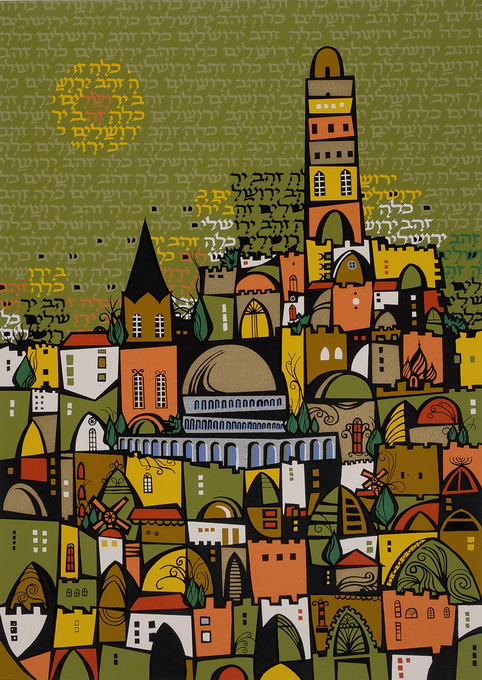
Naim Basson
Jerusalem of Gold
$200
Edition 160
Shipping & Handling: $30
Naim Basson was born in Iraq in 1935 and immigrated to Israel in 1950.
He studied painting and sculpture at the Avni Institute in Tel Aviv and at various art academies.
Basson’s wall paintings, reliefs and sculpture can be viewed in Maalot, at the Diplomat Hotel in Tel Aviv, the Marina Hotel in Bat Yam, the Caesar Hotel in Eilat, the Eyal Hotel in Eilat, the Tirat Hacarmel Hospital, the First International Bank in Tel Aviv, a 250 square meter relief at the Caesar Halls in Bat Yam and the biggest mezuzah in the world (4.8 meters) at the Israel Experience in Jaffa.
Basson’s works of art are exhibited in the collections of museums and galleries in Israel and the world over, at the Tel Aviv Museum, the Israel Museum in Jerusalem, the Kimche Gallery at the Tel Aviv Hilton, the Richter Gallery in Old Jaffa, the Engel Galleries in Tel Aviv and Jerusalem, the Bruno Galleries in Jerusalem and Tel Aviv, the William Rockhill Museum in Kansas City, the Skirball Museum in Los Angeles, and at the “Jewish Quarter” Galleries in Beverly Hills, Encino and New York.
Basson’s works are also to be found in the private collections of personalities and public figures, among them Jane Fonda, George Segal and others.
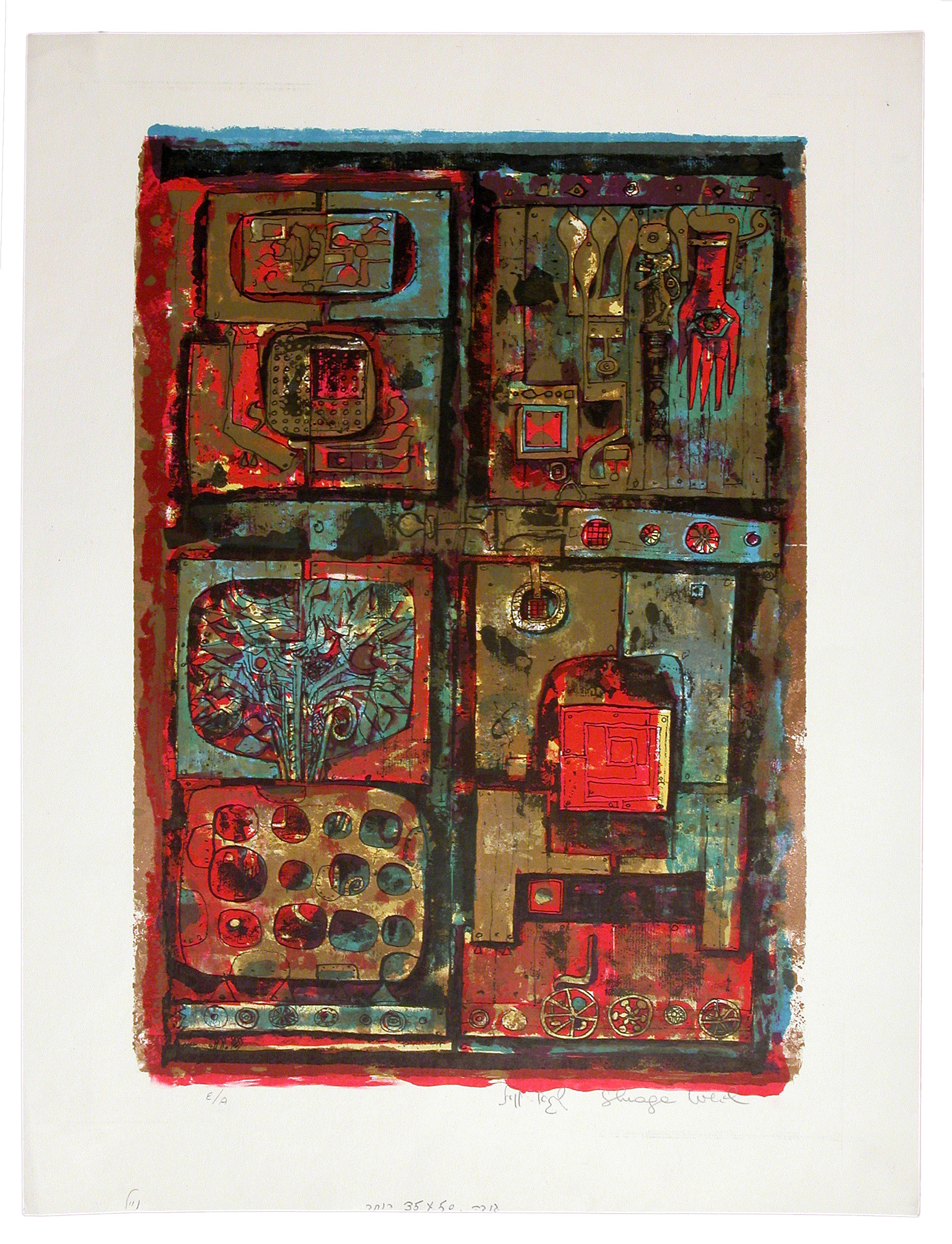
Weil Shraga
S-2 Gates of Jerusalem
$400
Serigraph1963 Edition 150
Shipping & Handling: $30
“The Gates of Jerusalem” are composed of numberous symbols and calligraphic designs. In the upper right corner of the work, ‘Jerusalem’ appears in Hebrew; beneath it the ‘Lion of Judah’ stands next to a hand with an eye – a form used as an amulet by Jewish mystics. In the upper left hand area, a design of letters creates the word ‘Jerusalem’ above the word ‘Israel’. The two panels on the left show the ram’s horns entangled in the bush above the breast plate of the high priest which includes twelve shapes, each representing one of the tribes of Israel.
Shraga Weil was born in Nitra, Czechoslovakia in 1918 to a family of teachers, journalists and merchants. His father, a building engineer, who was an amateur painter, sent him to study with a local sculptor and then to the Prague School of Art.
He produced his first graphic works during World War II, part of which he spent as a prisoner. After the war, Weil sailed for Israel on an illegal immigrant ship, eventually arriving in the new country in 1947 and becoming a member of Kibbutz Haogen, where he has been living ever since.
In 1954 Weil spent some time studying murals and graphic techniques at the Academie des Beaux Arts, Paris and Ravenna mosaics with Prof. Severinl.
Shraga Weil’s works have been exhibited in the United States, South America, Canada, Australia, France, the USSR, Switzerland, and in the International Exhibition of Graphic Arts, in Lugano. In 1959, Weil was awarded Tel Aviv’s Dizengoff Art Prize.
Museums and Public Collections
Brandeis University, Waltham, Massachusetts
Boston Public Library
Israel Museum, Jerusalem
William Rockhill Nelson Gallery, Kansas City, MO
Fogg Museum, Harvard University
Los Angeles County Museum
Jewish Museum, New York
Philadephia Museum of Art
Joslyn Museum, Omaha, Nebraska
Judah Magnes Museum, Berkeley, CA
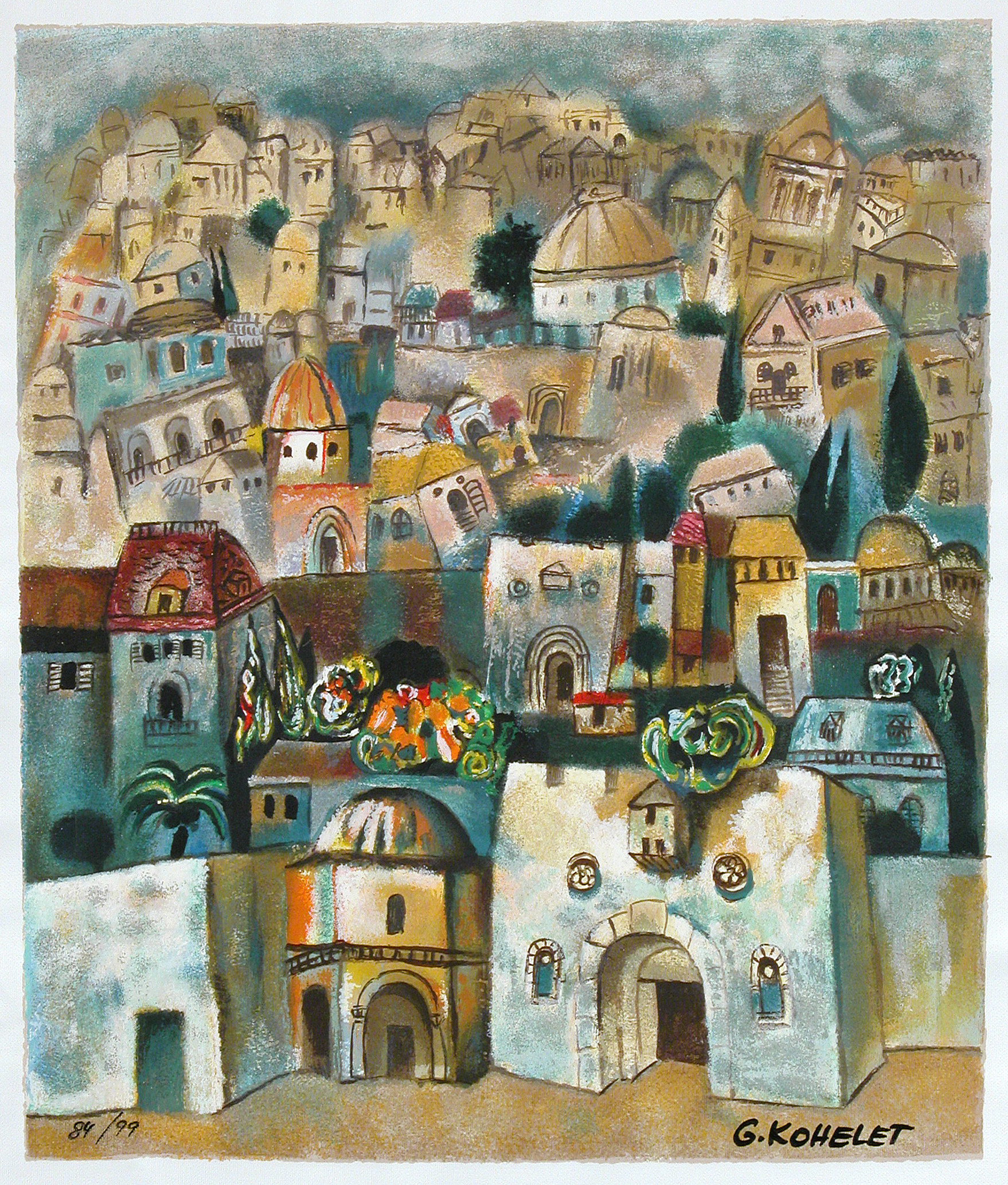
Gregory Kohelet
Jerusalem I
$200
Edition 99
Shipping & Handling: $30
Gregory Kohelet was born in 1954 in Fergana.
The son of a sculptor, Gregory was initiated into art by his father. He wasn’t pressured to learn “the classical laws of Art” but only to love and respect nature – the master teacher.
As a young boy, Gregory traveled with his father to wild landscapes with the intention of learning to understand the meaning of composition, color, and expression as they exist in Nature.
There, he listened to the music, understood the wisdom of the stones. Nature taught him to listen to silence. He thought that if he were to stay there he would become a Buddhist. But his was a different destiny.
He left his parents and his town Fergana at the age of 14 and went to study art in Tashkent.
He studied painting for 4 years at the Art College, and then for five more years at the Academy of Art.
He had excellent teachers, many from Moscow and St. Petersburg.
At College he was particularly influenced by Eastern art: Japanese, Chinese, Indian, while at the Academy he studied European Art: Giotto, Bruegel, Modigliani, More, Brancusi and Russian icons.
Yet he felt that his life’s course must pass through Jerusalem. In 1990 he immigrated with his family to Israel and settled in Jerusalem. In the holy city he absorbed much light and divine inspiration. He believes in G-d, but only in Jerusalem did he really “meet” him.
His influences from literature: The Bible essentially, Rilke, Matzu-Batzu (China), Lorca (Spain), Eluard (France)…
His influences from the world of music: Mozart, Bach, organ and liturgical (Armenian, Catholic, Jewish…)
His family is also a source of inspiration. His son Daniel – born in Jerusalem, his first son – born in Tashkent, and his wife, who dominates the female figure in his work.
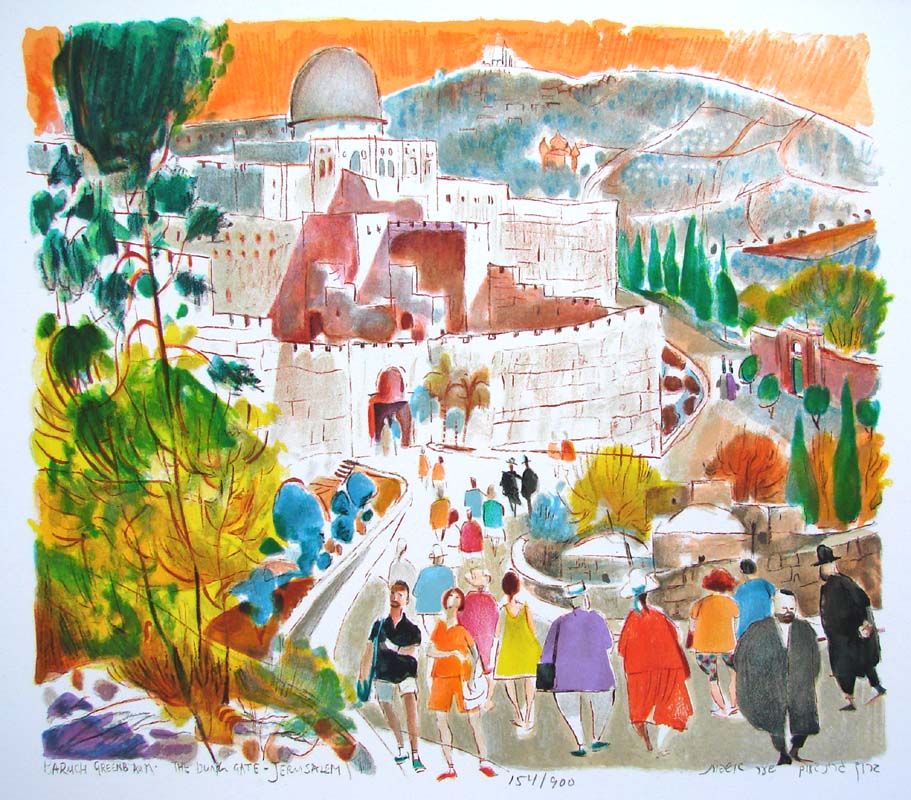
Baruch Greenbaum
Jerusalem Gates
$125
Lithograph1998 Edition 900
Shipping & Handling: $30
BARUCH GREENBAUM
Baruch Greenbaum was born in Brighton, Sussex, England and studied at the Brighton College of Art.
He was one of the first freelance designers to work for B.B.C. Television. He studied painting with Bernard Meninsky.
Greenbaum served in the British 8th Army and was demobilized in 1946. He returned to London to study design. In 1950 he opened his illustration and design studio in Fleet Street.
Greenbaum worked continuously for the National Press, Advertising and Publishing. He emigrated in 1973 to Israel and lived and worked in Safed. He passed away in 1992.
Baruch Greenbaum’s landscapes of the Judean Hills and his more urban landscapes depicting life on the streets of Jerusalem are easily recognizable by their vibrant colors. Often using red, initially to delineate the scene, Greenbaum then overlays these almost sketchy lines with bright colors.
Greenbaum’s Jerusalem is one of verdant greens and warm yellows and oranges. Trees, streets, people and buildings – all are bright in the brilliant sunshine. Also, using artistic license to the full – or perhaps it is just wishful thinking on Greenbaum’s part – his Jerusalem is a relaxed, unhurried place where all different types of people belonging to many different faiths, stroll in leisurely fashion along traffic free streets – somewhat different to the noisy, fast moving reality of the modern city.
Greenbaum’s graphics and watercolors illustrate the concept of Jerusalem which many people hold in their minds and which has a separate entity to the city itself. It is Jerusalem as he would like it to be – and in fact Jerusalem as it is, without the extra layer of modernity – an ancient and spiritual city.
